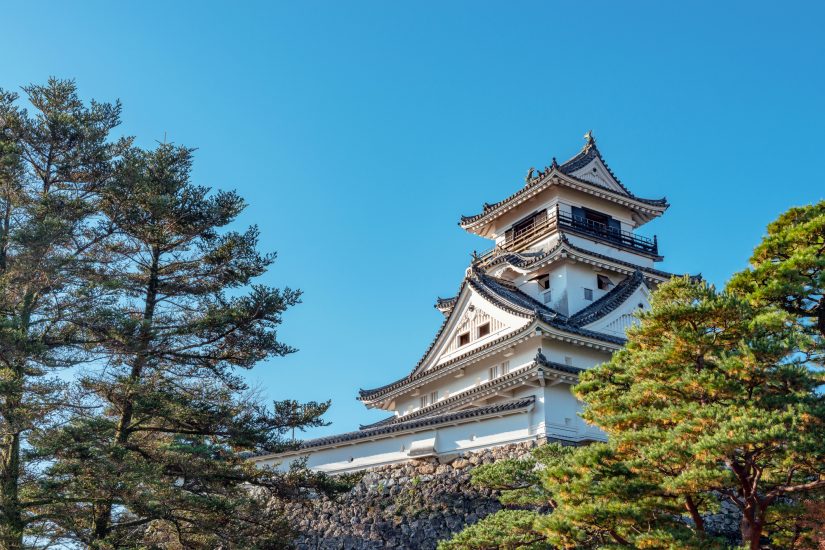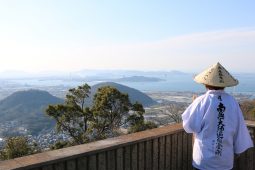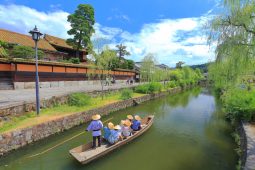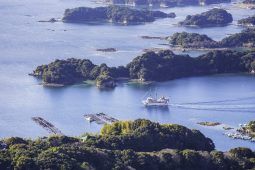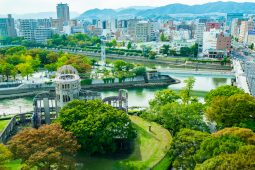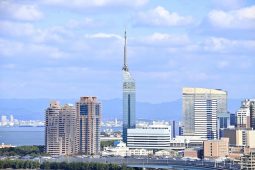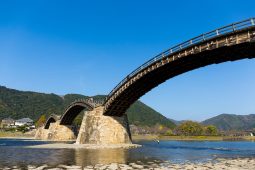The hustle and bustle of Tokyo, the largest metropolis in the world, often gives a rather mistaken impression of Japan as a whole. Most of the country is made up of green mountains and rugged coast, and offers some of the most beautiful natural scenery you’ll find anywhere. Nowhere is this more true than in Shikoku, a smaller island to the east of Honshu that borders on the Seto Inland Sea.
The island encompasses the four prefectures of Ehime, Kochi, Tokushima and Kagawa. The name, Shikoku, means “four states” and refers not to the four modern prefectures, but to the older states of Awa, Tosa, Sanuki, and Iyo. These names live on in several modern references, though, that you might spot as we go on.
The island as a whole is relatively non-industrialized, compared to Honshu, and agriculture is a major industry for all four prefectures. Thus, instead of the factories and shipyards you find along the nearby San-yo coast of Honshu, you’ll find clean beaches, fishing ports, and green mountains aplenty.
The island as a whole is a wonderful place to visit, and of course each prefecture has its own charms to enjoy. I hope this introduction spurs a few visits to this lovely part of Japan.
The 88 Temples
One of the island’s main claims to fame is the Shikoku Pilgrimage, or henro. Shikoku holds 88 Buddhist temples linked to the famous priest Kukai, also known as Kobodaishi, and every year thousands of pilgrims come to trek the 1,200+ kilometer path linking them all. The temples are spread over the entire island, and so crosses prefectural borders. There are now buses serving the pilgrimage so you don’t have to walk the whole way. You can also drive, bike, or even pay someone to be your pilgrimage surrogate.
The henro is a fantastic chance to experience real Japanese history and culture.
The Prefectures
*Kagawa
Many trips to Shikoku by land will pass through Kagawa, as the capital city of Takamatsu is connected to the major city of Kobe by bridge via a network of three bridges, and another network connects the prefecture to Okayama.
Takamatsu is home to both a castle, Takamatsu Castle with its seawater moat, and an Edo-period lord’s garden, Ritsurin-en, which are both lovely places to visit and sightsee.
In addition to the central city of Takamatsu, one of Kagawa’s highlights is “Art Island,” Naoshima. Naoshima is perhaps the most famous thing in Kagawa, as this small island in the Seto Inland Sea is home to an open-air art collection and some world-famous museums. Together with Teshima island, it hosts the Setouchi Triennale art festival every three years.
And of course, no discussion of Kagawa (or Shikoku in general) would be complete without mentioning udon. Kagawa has a reputation for being almost obsessed with the noodles, and there are 700 shops here serving versions of the local style, sanuki udon.
*Tokushima
Tokushima lies to the south of Kagawa, and is connected to Wakayama by ferry. It is a major agricultural area, of course, and has lots of things to interest travelers.
The first thing most Japanese people think of when they hear Tokushima is likely the Awa Odori 阿波おどり. It’s a unique festival around the Bon period (mid-August) where thousands of dancers line up in colorful traditional clothes and dance for kilometers. Hotels book up months in advance, so it’s important to plan ahead if you want to go!
Tokushima is also where you can see the famed Naruto whirlpools 鳴門の渦潮 (Naruto no uzushio), which might sound familiar from a certain anime and manga. These massive whirlpools form in the strait between Naruto city and Awaji island, where the Pacific Ocean and Seto Inland Sea meet. You can see them from ships or from the bridge spanning the strait, if you have a car.
And finally, if you are into mountain scenery, the Iya Valley is the place for you. It is a huge wooded valley filled with traditional old villages, vine bridges, and other scenery you just can’t find anywhere else. Access is limited, since the area roads are often too narrow for tour buses, but if you can get there, the scenery is stunning.
*Ehime
Ehime lies at the western end of Shikoku, and is connected to Honshu and Kyushu by several ferry lines. It looks out over the Seto Inland Sea facing Yamaguchi and Oita prefectures.
In addition, a series of bridges hopping from island to island in the Seto sea, called the Shimanami Kaido (officially the Nishiseto Expressway), connects Ehime to Hiroshima prefecture, and is built to allow foot and bicycle traffic. It’s a hugely popular cycling route, offering incredibly views of the Seto Inland Sea and Shikoku in the open air.
The capital Matsuyama hosts a castle and old town, as well as Dogo Onsen, which is the oldest hot spring inn still running in Japan. The location has been in unbroken use for 2,000 years, and is still popular with locals and tourists alike.
Outside of Matsuyama, a truly special place is Mt. Ishizuchi. This mountain is considered sacred to followers of a mountain-centered faith called Shugendo, which mixes aspects of Shinto and Buddhism. Some of the climbing paths can be quite difficult, with some passing climbing chains attached to the mountain face, but offer access to some truly amazing shrines and temples. There are alternate paths for those who can’t handle the extra exertion of the chain paths, as well.
*Kochi
Kochi is the largest, but least populated, of Shikoku’s prefectures. It is almost all mountain, and thus the interior is only sparsely inhabited. This also means that there are huge areas of pristine wildland to be found inland.
The capital city is also called Kochi, a relatively small port city, and the castle here is one of only 12 in Japan that is all original, meaning it is not a post-war rebuilding or replica. It also has a parkland mountain, Godaisan, which holds a temple included on the Henro pilgrimage.
But the real appeal of Kochi is the wilds. Travel can be difficult, especially if you don’t have a car, but a bit of trekking can take you to see the exquisite Shimanto River. Called “The last clear river in Japan,” its remote location means it has never been dammed or otherwise engineered. The lack of industrialization also means pollution levels are very low, and so it’s a popular place for fishing and gathering of nori seaweed.


